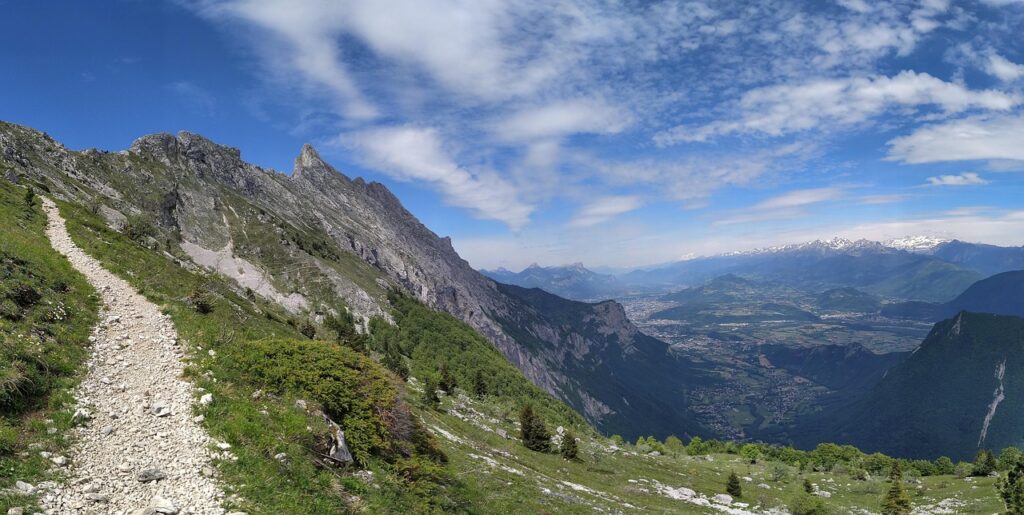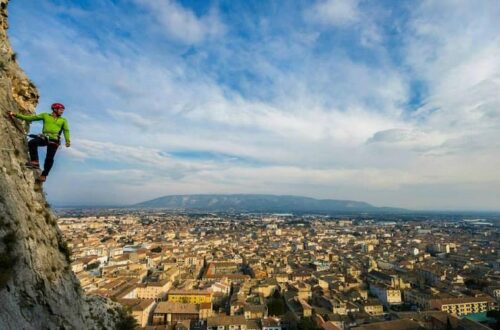You’ll Have a thrilling Adventure Above Grenoble with Via Ferrata de la Bastille.
High above the city of Grenoble in southeastern France, the Via Ferrata de la Bastille is a rare gem. It is a route that blends alpine thrills with urban accessibility. Where else can you step out of a bustling university town, strap on your harness, and climb a sheer rock face without ever leaving the city limits?
This via ferrata is a favorite among beginners, people who short on time, and anyone seeking to dip their toes into the vertical world — all without sacrificing scenery or challenge. With great views over the city, the Isère River, and the nearby Belledonne and Chartreuse mountains, this route packs a punch in a compact, convenient setting.

What Is a Via Ferrata?
Before getting into the Bastille route, it’s best to understand what via ferrata actually means. The term translates from Italian as “iron way,” a reference to the metal rungs, ladders, and cables that help climbers scale otherwise inaccessible cliffs. Via ferratas came from the Italian Dolomites during World War I as military routes and later evolved into a recreational sport in mountain regions across Europe — especially in France, Italy, and Austria.
Climbers are always secured to a steel cable using a special lanyard system. The mix of climbing, hiking, and exposure to big views makes via ferrata the perfect middle ground between traditional rock climbing and scenic hiking.
Click here for a wide range of fantastic adventures in Europe.
A Via Ferrata in the Heart of the City
What sets the Via Ferrata de la Bastille apart is its unusual urban location. It Starts from the banks of the Isère River which is just a 15-minute walk from Grenoble’s historic city center. The route quickly climbs the steep cliffs beneath the Fort de la Bastille — a 19th-century military fortification that looms above the city.
The Bastille is already a well-loved spot, accessible via the famous Grenoble-Bastille cable car (affectionately called “the bubbles”) or by foot via a zigzagging trail. But for thrill-seekers, the via ferrata offers a third — and much more vertical — way to reach the top.
Route Overview
The Via Ferrata de la Bastille is divided into two main sections:
1. The First Section – Beginner-Friendly
- Level: Easy to moderate
- Time: 30–45 minutes
- This section is suitable for adventurous beginners and offers steady vertical climbing with plenty of iron rungs and footholds. The exposure is real — you’re climbing above rooftops and highways — but the climbing itself is not too technical.
If you want a selection of practical, stylish and outdoors appropriate menswear, have a look at https://www.braveandboldmenswear.com/
This first part ends with an easy exit route, perfect for those looking to enjoy the experience without committing to the tougher second half.
2. The Second Section – For the Brave
- Level: Moderate to Difficult
- Time: 30–60 minutes
- This portion is steeper, more exposed, and physically demanding, with overhanging sections that need some upper body strength. You’ll cross a Nepalese bridge, navigate tricky transitions, and gain altitude quickly.
The route ends near the top of the Bastille fortress, where you can rest, take pictures and enjoy a celebratory snack with a view.

Equipment and Safety
The via ferrata is free to use but bring your own equipment:
- Helmet
- Harness
- Via ferrata lanyard with energy absorber
- Gloves (recommended for comfort and grip)
If you’re traveling without gear, several shops in Grenoble rent full via ferrata kits, and local guides can be hired for instruction or support.
Good shoes (trail runners or approach shoes) are a must. The rock can be slick in spots, especially after rain.
You need to be in good shape for Via Ferratas. Click here to turbocharge your health and fitness.
When to Go
The route is usually open from April to October, but it can open earlier in spring depending on weather conditions. Avoid it after rain, as the rock becomes slippery and dangerous.
Early mornings and weekdays offer a quieter experience — the via ferrata is popular with locals and can get busy, especially on weekends.
Click here for another fantastic Via Ferrata adventure.
Access and Approach
- From central Grenoble, go to the Jardin des Dauphins near the Porte de France bridge.
- A short, steep hike takes you to the base of the route, marked with a signboard showing the layout and difficulty.
Alternatively, you can take the cable car to the top of the Bastille and walk down to watch climbers on the route — a good option if someone in your group isn’t up for the climb.
Why It’s Special
🧭 Urban Meets Alpine
It’s not often you find a via ferrata just minutes from cafés, trams, and student hangouts. The mixture of natural rock and urban sprawl makes this route feel especially unique.
If you want to lose weight before attempting the Via Ferratas, click here.
📸 Incredible Views
You’ll see Grenoble like few others do — from hundreds of feet above, with the city laid out below like a map. On clear days, the Mont Blanc massif is visible in the distance.
🏰 A Historic Finish
Topping out near the Fort de la Bastille adds a historical layer to the climb. Once a military defense point, the fort is now a peaceful viewpoint with trails, museums, and picnic spots.
Good to Know
- Solo climbing is not recommended unless you’re experienced.
- There is no supervision or ranger presence — it’s a self-managed route.
- Kids under 12 should be roped in or climb with a guide.
- You’ll need a good head for heights — exposure is real, especially on the second half.
Post-Climb Treats
Once you finish the climb, reward yourself! Grab a drink at the café near the Bastille or take the cable car back down. If you’re feeling energized, descend via the scenic Montée Chalemont path, which snakes down the hill through lush forest.
Back in town, stroll through Grenoble’s Old Town, full of student vibes, art galleries, and Alpine cuisine. Fondue, anyone?
Final Thoughts
The Via Ferrata de la Bastille is more than just a climbing route — it’s a playful intersection of city life and mountain adventure, ideal for those who want a quick thrill with unforgettable views. Whether you’re a beginner trying your first ferrata or a seasoned climber wanting a quick fix between alpine missions, this urban ascent delivers.
Grenoble may be known as the “Capital of the Alps,” but for an hour or two, you’ll feel like the city is at your feet — quite literally.

